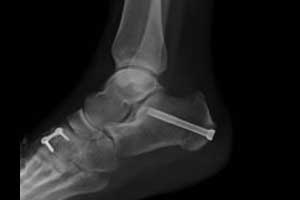- Home
- Editorial
- News
- Practice Guidelines
- Anesthesiology Guidelines
- Cancer Guidelines
- Cardiac Sciences Guidelines
- Critical Care Guidelines
- Dentistry Guidelines
- Dermatology Guidelines
- Diabetes and Endo Guidelines
- Diagnostics Guidelines
- ENT Guidelines
- Featured Practice Guidelines
- Gastroenterology Guidelines
- Geriatrics Guidelines
- Medicine Guidelines
- Nephrology Guidelines
- Neurosciences Guidelines
- Obs and Gynae Guidelines
- Ophthalmology Guidelines
- Orthopaedics Guidelines
- Paediatrics Guidelines
- Psychiatry Guidelines
- Pulmonology Guidelines
- Radiology Guidelines
- Surgery Guidelines
- Urology Guidelines
Surgical Management of Chronic Lateral Ankle Instability: Chinese Society of Sports Medicine Guidelines

The surgical management of chronic lateral ankle instability (CLAI) has evolved since the 1930s, but for the past 50 years, the modified Broström technique of ligament repair has been the gold standard.
Chinese Society of Sports Medicine has released new guidelines regarding Surgical Management of Chronic Lateral Ankle Instability. This guideline presents the most standard surgical management strategies for CLAI at the current time and will be revised every 5 years. The developers of the guideline believe that it will be helpful for surgeons to make evidence-based decisions when treating patients with CLAI surgically. Meanwhile, it is expected that this guideline to assist physicians and researchers in designing future studies according to the current understanding of operative treatment for CLAI.
Surgical Recommendations for CLAI
When Should CLAI Be Treated Surgically?
Recommendation
- When (1) patients exhibit symptoms of CLAI after 3 to 6 months of nonsurgical treatment; (2) physical examination reveals tenderness around the lateral ligaments or a positive anterior drawer test or talar tilt test; (3) the diagnosis of CLAI was also confirmed by stress radiography or magnetic resonance imaging (MRI), surgery is suggested (2C).
Do CLAI and Osteochondral Lesions Need to Be Addressed Simultaneously During Surgery?
Recommendation
- Management of osteochondral lesions (OCLs) of the talus or tibia and simultaneously torn lateral ankle ligaments in patients with CLAI could alleviate symptoms, and the short-term clinical outcomes are good postoperatively, so surgery of both lesions simultaneously should be a safe and reliable treatment strategy (2C).
Open Versus Arthroscopic Anatomic Repair for CLAI—Which Procedure Is Better?
Recommendation
- Patients undergoing either procedure can be expected to experience equivalent short-term functional outcomes (1B).
Open Versus Arthroscopic Anatomic Reconstruction for CLAI—Which Procedure Is Better?
Recommendation
- Patients undergoing either procedure can expect to experience equivalent short-term functional outcomes (1C).
Autograft Versus Allograft After Anatomic Reconstruction for CLAI—Which Graft Is Better?
Recommendation
- Neither type of graft has superiority over the other. Either autograft or allograft can be considered a promising candidate for anatomic reconstruction (1C).
Is It Necessary to Reconstruct the Calcaneofibular Ligament?
Recommendation
- When patients with CLAI have subtalar joint instability and both the ATFL and CFL are ruptured, ATFL and CFL reconstruction should be taken into consideration (2C).
Rehabilitation: When to Start Range of Motion and Weightbearing Exercises?
Recommendation
- For patients who undergo anatomic repair or reconstruction, range of motion (ROM) (mostly dorsiflexion) and partial weight-bearing with a brace are encouraged from the second day after surgery. For patients with OCL who undergo anatomic repair or reconstruction and additional microfracture, early ROM is advised to avoid the limitation of joint mobility, while weight-bearing should be relatively delayed (1C).
What Measurements Should Be Used as Criteria for Return to Sports?
Recommendation
- Joint stability, muscle strength, and full ROM are important indicators in terms of returning to sports after surgery (1C).
Assessment of Outcomes for CLAI
Recommendation
- The measurement most commonly used by clinicians is the AOFAS score, followed by the Karlsson score, and the evaluations most commonly used by patients are the VAS score and Foot and Ankle Ability Measure (FAAM) scale. The most commonly used objective assessments are the talus tilt test and the anterior drawer stress radiograph (1C).
- Surgery is suggested when patients continue to have symptoms of CLAI after 3 to 6 months of nonsurgical treatment and have indications of CLAI on physical and imaging examinations (stress radiography or MRI).
- Simultaneous surgery for CLAI and OCL lesions of the talus or tibia is suggested when both are present.
- Open and arthroscopic procedures are both recommended in patients with CLAI who undergo anatomic repair or reconstruction.
- Autograft and allograft are both recommended for anatomic reconstruction in patients with CLAI.
- When patients with CLAI have subtalar joint instability and both the ATFL and the CFL are ruptured, ATFL and CFL reconstruction is suggested.
- For patients with CLAI who undergo anatomic repair or reconstruction, ROM (mostly dorsiflexion) and partial weightbearing with a brace from the second day after surgery are recommended; for those with OCL who undergo anatomic repair or reconstruction and additional microfracture, early ROM and relatively delayed weightbearing are recommended.
- Joint stability, muscle strength, and full ROM are recommended prior to returning to sport after surgery.
- The AOFAS score, Karlsson score, VAS score, FAAM scale, talus tilt test, and anterior drawer stress radiographs are recommended to assess CLAI.
For more details click on the link: https://doi.org/10.1177/2325967119873852

Disclaimer: This site is primarily intended for healthcare professionals. Any content/information on this website does not replace the advice of medical and/or health professionals and should not be construed as medical/diagnostic advice/endorsement or prescription. Use of this site is subject to our terms of use, privacy policy, advertisement policy. © 2020 Minerva Medical Treatment Pvt Ltd